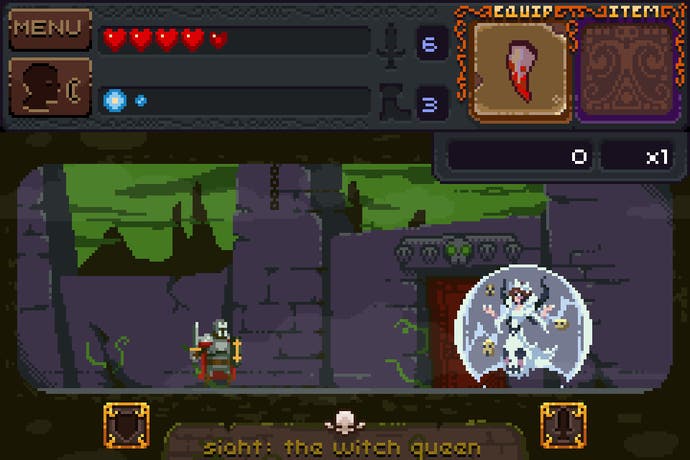Deep Dungeons of Doom review
Roguelite.
Few collaborations initially instill such a warm feeling as this one: MiniBoss, the brilliant Brazilian team behind the ingenious puzzle-platformer Out There Somewhere, working together with Bossa Studios, the people who brought us Surgeon Simulator 2013. Then there's the name. Deep Dungeons of Doom: the perfect invitation for anyone who's ever looked at the map in the front of one of those fantasy paperbacks or rolled a wizard on a mimeographed character sheet before sitting back for a second, eyes closed, to dream of glory. From such an auspicious start, this clever and streamlined lootfest can't quite live up to your expectations, perhaps - but it tries to.
Streamlining is the operative concept here: you choose from one of three character classes - Crusader, Witch and Mercenary - and then you leap from a tantalisingly empty world map into a series of forbidding dungeons. Each floor contains a single creature for you to fight using just two buttons, one for attacking and one for defence. Attacking always leads to a cooldown, but there's bonus damage to be dealt if you get your timing just right. Defending then elaborates on this rhythmic conceit, encouraging you to read your foe for tells so as to raise your shield at the last possible moment. Blocked!
Each enemy comes with their own quirks, their own pace for you to settle into, and they die in a shower of coins and - occasionally - loot. Loot itself comes in two varieties - equipment, which provides a muddle of perks for as long as you're holding onto it, and items, which generally take the form of consumables such as potions. Throw in a magic meter alongside your health bar and a two-slot inventory restriction, and you have a neat little RPG that encourages you to play at full pelt, tapping your way through combat and then swiping upwards to move deeper into the dungeon, where bigger and badder beasties await.

As you might be starting to suspect, 'deep' is, ironically, a word that doesn't really apply here, despite a series of character upgrades you can pay for at various altars dotted around the landscape, and a range of simple timing gimmicks for recharging and bonus damage that bring a touch more thought to the combat. If it's not really the systems that keep you diving through the game's handful of dungeons, though, the art style certainly provides some incentives: wonderfully fiddly pixel-art delivers everything from evil fairies to headless horsemen with a glorious degree of character and wit. Enemies burn up and collapse when defeated, coins sail through the air as they're freed from treasure chests, and even the incidental images that accompany pre-level text convey a genuine old-school flavour. Bosses, meanwhile, crackle with electrical energy or emerge from columns of twisting smoke - and at least one of them brings with it a nod to a beloved Zelda foe.
A little more substance would make the steady trickle of in-app purchases easier to stomach, perhaps, although you do get a decent chunk of the game gratis. Download the free version, and you'll find five dungeons to explore and access to the complete trio of character classes, while a further £1.99 will net you another six dungeons, including one that keeps throwing enemies at you forever. Elsewhere, you can pay for extra in-game currency or additional continues, called revives. Revives are a little pricier than I was expecting, to be honest, and they can be unpleasantly hard to resist when you're bleeding out on the final boss of a lengthy adventure with a lot of progress at stake. Still, approach it as a win-everything, lose-everything roguelike and the game seems fairly balanced for the most part - and you can have a good few hours of mild fun without spending any money at all.
It is mild fun, though, and there's no real escaping that. If Deep Dungeons of Doom ultimately feels a tiny bit hollow, this may in part be due to its dazzling presentation. Its pixelated villains and spooky landscapes immediately transport players away from their touchscreens and back to an era when games that looked like this were regularly expected to keep you engrossed for days on end - so it's a little bit of a shock to find that, this time, the whole thing's actually been built on far more modern foundations.

